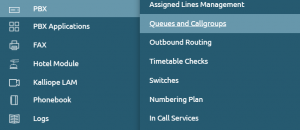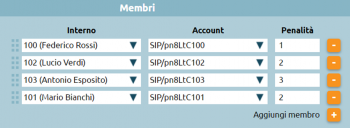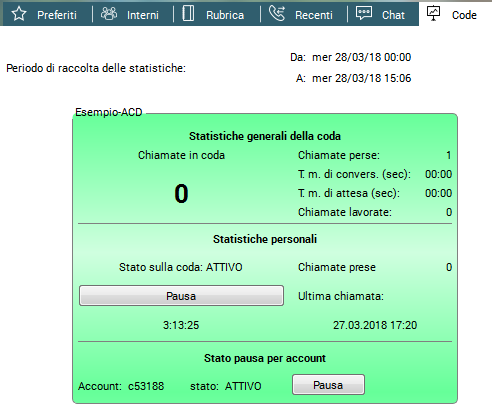AdminGuide:Service:ACD
Return to AdminGuide:Service
Description
The Automatic Code Distribution (ACD) service, also known as the "waiting queue" service, provides professional telephone reception by keeping callers waiting until an operator becomes available. The incoming call is taken over by the central unit that presents the caller with a series of information through audio files, hold music, and puts the callers in a queue to distribute them to the various operators of the queue (or members) based on specific commitment policies that can be configured within each queue. The "Queues" are a mechanism analogous to the Call Groups, from which they differ for the possibility of defining in a more refined way the ringing strategy and for the sorting of the incoming calls, which are queued and served with a FIFO (First In First Out) policy towards the members of the queue. Each queue can be associated with an arbitrary number of members (accounts), who will serve the calls addressed to it. It is important to remember that an operator can be busy on more than one queue at the same time. In case of concomitance of calls waiting on more than one queue, the service will present to the operator the call coming from the queue with the highest priority.
Configuration
To access the service just click on "PBX" > "Queues and call groups". We'll be on the page dedicated to the list of configured queues with the main parameters. By clicking on "Add new queue", we can move on to the configuration of the new queue.
There are the following fields:
- Enabled: a button that allows to select the queue as active/inactive
- Name: you can insert the name you want to give to the queue (e.g. "Assistance")
- Priority: numerical value that allows you to define which queue should have priority over the others, the higher the value, the higher the priority
- CLID name prefix: the prefix is added to the caller ID (CLID) and allows to indicate on the display of the telephone terminal the specific queue from which the call comes (e.g. "ASS" for "Assistance")
- Checktime: it is possible to choose the time controls already previously configured
Members
We can defines the list of operators assigned to this queue. To add them, just click on the "Add Member" button, you can choose between several extensions and select account for each one. If the extension has more than one account assigned, you can choose on which account (terminal) to commit the extension. The Penalty is a value that can be assigned to each operator: the lower the value, the greater the chance of being engaged by the queuing engine. The lower the penalty, the more the operator is a holder of the service of that queue.
For the penalty-based distinction to work, the ringing strategy (field present in the "Queue Parameters") must be of type ringall, i.e. all operators must ring (there is no targeted distribution on the single operator). Therefore, only the available operators with the lowest penalty will be engaged. Below there's an example of member list of a queue:
If the operator commitment policy is set to "RingAll", only the available operators with the lowest penalty will ring. In the specific case of this example, if extension 100 is not already busy, unregistered or paused, it will ring. Otherwise, extensions 102 and 101 would ring at the same time. If these extensions are also busy, unregistered or paused, extension 103 will ring. IMPORTANT NOTE: if an operator with the lowest penalty does not answer, also if it is available, the queuing engine will not pass the call to the operators with the next higher penalty but will continue to make the operator with the lowest penalty ring. In the specific example, if extension 100 is available, the queue will always let it ring until it answers, without scaling to extensions 102 and 101 with a higher penalty.
Queue Parameters
- Auto pause enabled': functionality that pauses an operator who does not answer a queued call. The operation of this option changes depending on the ringing strategy you choose. In the case of "ringall" it is not important: the automatic pause is not activated. The concept of automatic pause is introduced for callcenter features that allow the central unit to define the roles of supervisor and queue operator. If a user is a queue operator, one of the possibilities is "to pause". A "paused" user is a user who is registered, available and free at telephone level, but cannot be engaged by the queue. The pause/non-pause status is traced in the central unit registers, in order to control the pause time of the operator. The pause is managed through codes that we've already seen in the section of the "Numbering Plan" and by typing the codes - that can be customized - it is possible to pause or un-pause.
- Ring Strategy: drop-down menu that allows you to define the commitment policies of the operators on the queue, i.e. the way the system distributes the incoming calls in the queue to the various operators. Drop-down menu choices:
‣ Ringall: the call arrives at the same time to all free operators in the queue, taking into account the penalty values.
‣ Linear: the call is forwarded to the first free operator according to the sequence in which the members of the queue have been defined (from top to bottom) ignoring the concept of penalties which only applies to ringall
‣ Less recent: assigns the call to extensions that have not answered the call for the longest time. The queuing engine of the central unit takes into account the last time the operator served a call from the queue and, consequently, assigns it exclusively to the extension that has not answered the call for the longest time
‣ Fewestcalls': assigns the call to the operator who has answered the least number of calls that is calculated on the current day, unless the central unit restarts
‣ Round robin memory: distributes calls with round robin mode among available operators and remembers the last one that tried to call
‣ Round robin ordered: like RRMemory, but the order of the operators given in the configuration file is respected
‣ Random: assigns the call randomly among the available operators
- Ring timeout: indicates how many seconds the terminal of the engaged operator should ring (e.g. 15 sec). During these seconds, if the conditions change (another operator becomes free and we are in a ringall policy) the queue will not present the call to the operator who has just become free in the meantime, but will include him in the pull of the callable operators only at the expiration of the next ring timeout
- Retry interval: the engaged operator rings for a specific number of seconds, there will be a wait of e.g. 5 seconds and then it will go to choose the next operator according to the selected ringing strategy; it will ring again for 15 sec. During the 5 seconds the caller is in the queue and no operator rings.
- Rest interval: indicates the time (sec.) for which the operator who has just ended the call service (related to the queue), will not be engaged by the queue
- Announce sound file: option that allows to select a previously loaded audio file. When the operator answers the call, before being connected to the caller, he will listen to an audio file that will remind him which queue the call came from. This kind of option is useful for multiservice call centers that answer on behalf of third parties, for the operator - sometimes - it is functional to present himself to the caller
- Report hold time enabled: this option allows you to tell the operator how long the caller has been on hold.
- Ring in use enabled: allows to activate an option if a queue is particularly important, for example related to a high priority service. When engaging operators you ignore
- Max waiting time (sec.): parameter that monitors the maximum waiting time beyond which an overflow action is triggered (see below).
- Maximum length: parameter that monitors the maximum number of users allowed in the queue beyond which an overflow action is triggered (see below). (e.g. by entering 0 there are no limitations)
- Failover: We can perform an audio file and then an failover action, which can be chosen in the drop-down menu
Configuration
The service can be enabled/disabled and configured in the PBX -> ACD and ring groups page.
CTI integration
You can make use of certain features of the ACD service, such as adding dynamic operators, pausing operators, and accessing the supervisor panel, directly from Kalliope CTI and Kalliope Attendant Console.
You can, for example:
- activate the Call Center license from System settings -> LIcenses;
- in multi-tenant systems, assing the license to the desired tenant;
- assign a role to a user.
Upon opening Kalliope CTI, you will have available:
- a new tab allowing you to view the queues you belong to and change your pause status if necessary;
- for supervisors, the supervisor panel.
Utenti della coda
- Messaggi di benvenuto: è possibile selezionare un file audio precedentemente caricato
- Classe di musica d’attesa: il chiamante, dopo il messaggio di benvenuto, può ascoltare una musica di attesa (caricata precedentemente) o il normale tono di squillo
- Annuncia la posizione in coda: opzione che permette la comunicazione al chiamante della propria posizione in coda
- Frequenza annuncio di posizione in coda (sec.): inserimento di una cifra che indica ogni quanti secondi aggiornare il chiamante del suo posizionamento in coda
- Annuncia il tempo di attesa stimato: calcolato sulla base delle statistiche del motore di accodamento, è possibile scegliere se annunciarlo ogni tot di secondi come la frequenza di annuncio della posizione in coda, solo una volta, o non annunciarlo.
Questo messaggio si innesca soltanto qualora il tempo di attesa medio sia superiore ai due minuti
Annuncio periodico personalizzato
Strumento adottato, ad esempio, per comunicare al chiamante determinate procedure. È utilizzato per offrire informazioni più frequenti in richiesta a una determinata coda
- Abilita l’annuncio periodico: è possibile selezionare l’abilitazione dell’annuncio
- File audio per l’annuncio periodico: è possibile selezionare un file audio precedentemente caricato
- Intervallo di riproduzione dell’annuncio periodico (sec.): inserimento del tempo (in sec.) dopo cui partirà ciclicamente il messaggio periodico
Messaggio su richiesta
- Abilita la riproduzione su richiesta dell’operatore: è possibile selezionare l’abilitazione del messaggio su richiesta
- File audio per la riproduzione su richiesta: è possibile selezionare un file audio precedentemente caricato
- Sequenza da digitare per l’avvio dell’annuncio su richiesta: sequenza che dovrà digitare l’operatore in conversazione su questa coda per scatenare il file audio caricato. (Es. l’operatore fa ascoltare determinate condizioni al cliente tramite la digitazione di un codice personalizzabile)
Richiamata su occupato
Servizio abilitato nel caso in cui sulla centrale viene assegnata la licenza callcenter. Consente al chiamante in attesa di non restare fisicamente al telefono per tutto il tempo prima di essere preso in carico da un operatore, ma si dà la possibilità – premendo il tasto 5 – di restare virtualmente in coda. Viene eseguito un IVR di sistema che chiede al chiamante se desidera essere ricontattato sull’attuale numero o se vuole essere richiamato su un altro numero (da specificare). L’utente rimane virtualmente in coda e la sua posizione non cambia, al suo turno la centrale chiama l’operatore disponibile che comunicherà alla centrale di innescare la richiamata verso l’utente che si era prenotato.
- Abilitato: è possibile può selezionare la richiamata su occupato
- Classe di instradamento in uscita: es. Italia no cellulari, se si inserisce un numero di cellulare il numero non verrà richiamato
- Identità in uscita: è una chiamata dalla centrale verso fuori, è possibile trattare il numero in uscita come se il chiamante fosse un interno già configurato
Integrazione con CTI
E’ possibile fruire di specifiche funzionalità messe a disposizione da ACD direttamente dai software Kalliope CTI e Kalliope Attendant Console quali ad esempio aggiunta dinamica degli operatori, metter in pausa gli operatori, accedere al supervisor pannel.
Si consideri il seguente esempio:
- attivare la licenza del modulo call center da Impostazioni di Sistema -> Licenze
- nel caso di versione multitenant, assegnare la licenza al tenant desiderato
- assegnare il ruolo di Supervisore all’utente preposto
All’apertura del software Kalliope CTI si avrà a disposizione:
- Un nuovo tab che consente di visualizzare le code a cui appartiene ed eventualmente mettersi in pausa.
- Nel caso di ruolo di supervisore è possibile accedere al Super visor panel











